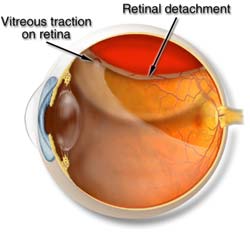Retinal Detachment

The retina covers the back inside wall of the eye. When light hits the retina, an image is formed and messages about this image are sent to the brain and vision occurs. A healthy retina is needed for good vision.
When the retina comes away from the back of the eye it is called a retinal detachment.
You may experience light flashes, large floaters or shadows with partial or complete loss of vision. If not treated early, it may result in a permanent vision loss.
What is it caused by?
Sometimes the cause is unknown. Aging of the eye can cause the gel-like fluid in the eye to shrink causing a detachment. A hard blow can also result in a detached retina. Sometimes, other diseases such as diabetes, some tumors or inflammations can cause detachments as well. This can also be a complication of ocular surgery including cataract.
How is it treated?
If you are unable to be seen by your own physician or optometrist within 24 hours, Misericordia Health Centre is open 24/7 for eye emergencies (present at Patient Registration through 99 Cornish Avenue entrance) OR visit an Urgent Care Centre OR visit an Emergency Department where a physician will do an assessment of your eye issue and make a referral to an ophthalmologist if required. Repair of the detachment can be accomplished by laser, cryopexy (cold therapy), or an application of a silicone band on the sclera of the eye to push the retina back into place. Sometimes the surgeon must perform a vitrectomy which cuts away part of the gel in the eye, then replaces it with air or gas to push the retina against the back of the eye. You must follow the surgeon’s instructions carefully after the procedure regarding positioning of your head to keep the air / gas bubble in the right place.
Please refer to the Patient Guide Before Vitrectomy Surgery – English or French. Should you have questions regarding any information on the instructions, call the Preoperative Assessment Clinic (POAC) at 204-788-8531.
Refer to the instruction Guidelines Following Retinal Detachment or the Post-vitrectomy positioning guidelines – English or French) for postoperative information.

